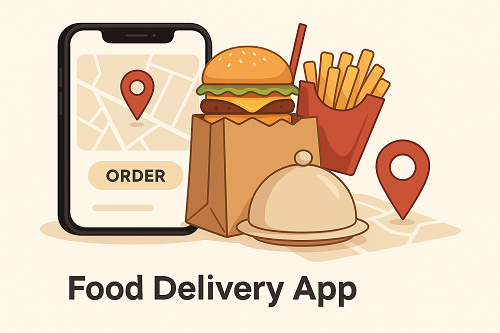The food delivery industry is undergoing a major technological revolution. What once relied heavily on manual operations, phone orders, and human-driven logistics is now evolving into a sophisticated, AI-driven ecosystem. Businesses looking to thrive in this competitive market need to adopt intelligent solutions. A modern food delivery app solution powered by AI and automation can streamline operations, enhance customer experiences, and boost profitability.
In this blog, we explore how AI and automation are reshaping food delivery apps and why businesses must embrace these innovations to stay ahead.
1. Enhanced Customer Experience Through Personalization
One of the most noticeable impacts of AI in food delivery is the ability to deliver highly personalized experiences. AI algorithms analyze user behavior, order history, preferences, and even dietary restrictions to offer tailored recommendations.
Benefits include:
- Personalized menu suggestions based on past orders
- Smart upselling and cross-selling of dishes
- Customized promotions and discounts
By delivering a curated experience, food delivery apps not only increase user satisfaction but also encourage repeat orders, thereby driving revenue growth.
2. Optimized Delivery Routes and Logistics
Delivery efficiency is crucial in food delivery services. AI-powered route optimization helps drivers take the fastest, least congested paths, reducing delivery time and operational costs.
Automation tools integrated into the app can:
- Assign orders to the nearest available driver
- Predict delivery times based on traffic and weather conditions
- Monitor driver performance in real-time
Optimized logistics ensure that meals reach customers hot and fresh, which directly improves customer satisfaction and loyalty.
3. Predictive Demand and Inventory Management
AI can forecast demand based on factors such as time of day, day of the week, weather, local events, and historical ordering patterns. Restaurants and delivery platforms can leverage this data to manage inventory more effectively.
Key benefits include:
- Reducing food waste
- Ensuring popular items are always available
- Streamlining kitchen operations for faster order fulfillment
Predictive insights help both restaurants and delivery platforms maintain operational efficiency while meeting customer expectations consistently.
4. Automated Customer Support
Customer queries can be repetitive, ranging from order status inquiries to menu details. AI-powered chatbots integrated into food delivery apps can handle these interactions seamlessly.
Advantages include:
- Instant responses to frequently asked questions
- 24/7 support availability
- Freeing human agents to focus on complex issues
Automation in customer service improves response times and satisfaction, creating a more positive brand experience.
5. Fraud Detection and Secure Payments
With the rise of digital payments, ensuring secure transactions is critical. AI algorithms can detect unusual patterns and flag potential fraud in real-time.
Benefits for food delivery apps include:
- Protecting user payment information
- Reducing chargebacks and fraudulent activities
- Enhancing trust between customers and the platform
Security automation ensures customers feel safe when using the app, which is essential for retention and credibility.
6. Dynamic Pricing and Promotions
AI allows food delivery platforms to implement dynamic pricing strategies. Prices can be adjusted based on demand, location, time, or customer behavior. Additionally, automated promotional campaigns can be personalized to specific users or segments.
Advantages include:
- Maximizing revenue during peak hours
- Attracting new customers with targeted offers
- Increasing average order value through personalized upselling
Automation in pricing and promotions ensures that the business remains competitive while optimizing profits.
7. Advanced Analytics for Business Insights
AI-driven analytics provide actionable insights that help businesses make informed decisions. By examining customer preferences, peak ordering times, delivery performance, and menu popularity, companies can continuously refine their strategies.
Key benefits include:
- Identifying underperforming menu items
- Improving marketing campaigns
- Optimizing resource allocation and staffing
Data-driven decision-making powered by AI ensures that a food delivery platform remains agile and adaptive in a rapidly changing market.
8. Voice Ordering and Smart Assistants
Voice technology, integrated with AI, is becoming a significant trend in food delivery. Users can place orders through voice commands using smart assistants or app-based voice features.
Benefits include:
- Faster and hands-free ordering
- Enhanced accessibility for visually impaired users
- Reduced friction in the ordering process
Voice ordering combined with AI ensures convenience and a futuristic experience for tech-savvy customers.
9. Efficient Multi-Restaurant Management
For apps hosting multiple restaurants, AI and automation simplify operations. Restaurants can automatically update menus, manage orders, and track delivery performance without manual intervention.
Features include:
- Automatic menu adjustments based on availability
- Real-time inventory alerts
- Performance dashboards and automated reporting
Automation in multi-restaurant management ensures smooth operations, even during high-demand periods, keeping both partners and customers satisfied.
10. Sustainability and Waste Reduction
AI can also contribute to environmental sustainability by optimizing delivery routes, predicting demand accurately, and reducing food waste. Automated systems can suggest portion adjustments, highlight surplus stock, or reroute deliveries to minimize waste.
Benefits include:
- Lower operational costs
- Positive brand image for environmentally conscious consumers
- Reduced carbon footprint from deliveries
Sustainability-focused automation is a win-win, benefiting businesses, customers, and the planet.
Conclusion
AI and automation are no longer optional enhancements—they are transformative forces for food delivery platforms. From personalized experiences and predictive analytics to automated customer support and sustainable operations, a modern food delivery app solution must harness these technologies to remain competitive in 2025.
By integrating AI and automation, businesses can:
- Enhance customer satisfaction
- Improve operational efficiency
- Reduce costs and waste
- Increase revenue and retention
The future of food delivery lies in smart, automated systems that understand customer needs, streamline logistics, and provide actionable insights. Companies that adopt these innovations now are poised to lead the market, offering faster, more personalized, and highly reliable food delivery services.
Investing in AI and automation today ensures that your food delivery platform is not just surviving—but thriving—in a fast-evolving digital landscape.

